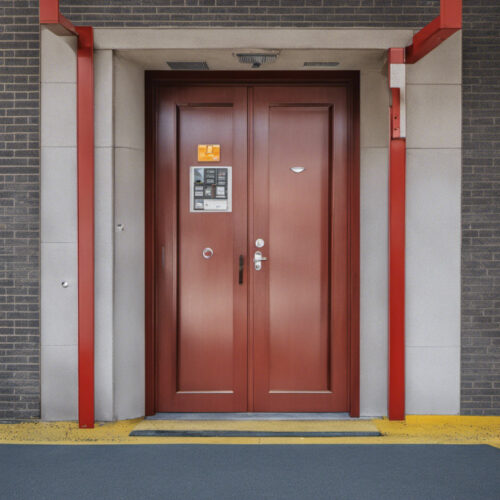In the realm of fire safety, the presence of an effective – and most importantly compliant – fire door can mean the difference between life and death. Fire doors are a fundamental component of the fire safety strategy for any building, ensuring that occupants have sufficient time to evacuate safely in the event of a fire.
For many of us, however, fire doors can often fade into the background. We may not recognise which doors are fire doors, or spot the problems with a fire door that can prevent it from working properly. So what exactly is the point of fire doors, and why is proper fire door compliance so crucial?
Understanding fire door compliance
Fire doors are designed and built to withstand the rapid spread of fire and smoke. They are most often found at key access points within a building, such as stairwells or corridor entryways. This is because these areas are most vulnerable to spreading fire and smoke, as they connect directly to multiple other parts of a building.
Their primary function is to compartmentalise a building, holding the fire back for a set period depending on their level of protection. Some fire doors for instance may offer 60 minute protection from most fires, or 60 minutes from an intense hydrocarbon fire. They are also commonly used for doors in flats and apartment buildings to compartmentalise different living quarters, containing a fire within as much as keeping one out.
The effective use of fire doors keeps fires from spreading to key escape routes, allowing people to evacuate from a building safely. If a fire door is not compliant with established standards or is poorly maintained, however, its efficacy diminishes. Even one door letting fire or smoke through could cut off a key escape route, placing lives at risk.
Fire doors and UK fire safety
Recent data from the UK Home Office revealed that there were around 182,000 incidents attended by fire and rescue services in the UK during 2020-21. While many of these incidents are addressed without casualties, any compromise in fire safety can escalate an incident, leading to tragic consequences.
The Grenfell Tower fire in 2017 is an unfortunate testament to the importance of fire door and fire safety compliance. The tragedy, which resulted in 72 deaths, served as a brutal wake-up call for the UK, highlighting several inadequacies in fire safety protocols and building regulations.
The fire doors in this incident were seen as a reason for people to shelter in place, as it was generally felt that it was safer for people to stay put in high-rise fires, and to wait for rescue rather than get lost in the smoke. While this had proved a reasonable strategy in other incidents, it relied on the fire doors being in good working condition, and was negated by the fire spreading quickly through the exterior cladding.
Following the Grenfell incident, the UK government initiated a comprehensive review of fire safety laws. The result was the Fire Safety Act 2021, which seeks to bolster fire safety in buildings, especially multi-occupied residential ones. Among its provisions, there’s a clearer definition of the roles and responsibilities of building owners and managers, particularly concerning regular inspections of fire doors and other safety measures.
The consequences of fire door failure
The implications of non-compliant or faulty fire doors are not restricted to the UK. Various incidents worldwide illustrate the devastating consequences when fire safety measures, including fire doors, fail to perform their intended function.
Lakanal House, 2009, UK
A tragic fire in South London led to six fatalities. The subsequent investigation identified that several fire doors did not provide the necessary fire resistance, primarily due to poor maintenance and modifications.
Knowsley Heights, 1991, UK
A fire at this Liverpool tower block spread more rapidly than expected due to the absence of fire barriers, including compromised fire doors. Though there were no fatalities, the incident emphasised the importance of maintaining fire safety systems.
Pang Warehouse, 1993, Singapore
This tragic fire resulted in the death of six individuals. A significant factor was the presence of non-compliant fire doors, which failed to contain the fire, allowing it to spread rapidly and trap victims.
Miryang Hospital, 2017, South Korea
A fire in a hospital in Miryang killed 37 people and injured more than 100. A key factor in the rapid spread of the fire was the building’s lack of sprinklers and non-compliant fire doors. The disaster led to a nationwide examination of fire safety in public buildings.
Ghost Ship Warehouse, 2016, USA
In Oakland, California, a warehouse known as the “Ghost Ship” caught fire, leading to the death of 36 individuals. Among other fire code violations, the structure lacked appropriate exits and fire doors, which contributed to the high death toll.
Childers Palace Backpackers Hostel, 2000, Australia
A tragic fire in this hostel killed 15 backpackers. Investigations revealed that while there were multiple factors contributing to the scale of the disaster, compromised fire exits and doors played a significant role.
Fire door compliance isn’t just a legal obligation; it’s a moral one. These seemingly mundane items play a crucial role in building fire safety, protecting both key access points and living spaces in multi-tenancy buildings. By ensuring that fire doors are up to code, properly maintained, and routinely inspected, we can safeguard lives, and prevent incidents like the ones above from ever happening again.

